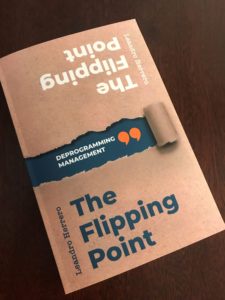Our traditional management education has almost 100% focused on the formal organization, the structural fabric of teams, divisions, groups, committees and reporting lines. The informal organization, often also called the ‘invisible organization’, has always been a ghost: you know it’s there but can’t see, can’t manage, can’t measure, so I don’t do anything about it. Not many years ago many leaders considered the informality side as a waste, a detractor from the core and formal, that is, doing your job. It seems yesterday when a friend of mine, a very successful business owner, spent a lot of time writing (hand writing for his secretary to type) memos to staff about how not use email for personal reasons, or the internet for that matter. Forget that online shopping and Ticketmaster deal. Not in his company.
Today, the role of the informal organization is more recognised. But still it is important to remind ourselves of what the informal social networks inside the organization, the web of connections, the largely (but not totally) invisible side does, and why it is inexcusable for leaders today to ignore it, or even treat it as an anecdote.
- Connectedness (= network) Obviously! The issue here is fluidity. Informal social networks inside the organization could become non fluid if you attempt to formalise them, ‘convert them into a team’ or corporatize them. They then become clubs (women in leadership, expats) which have their own utility, but they are not strictly speaking an informal network. The real connectedness dwells in the informal organization, well above the ‘forced connectedness’ of teams and task forces.
- Information traffic and communication. The travel, the social life of information, uses two highways: the top down hierarchical system of communication (the pipes) and the informal network (chatter, rumours and all versions of Chinese whispering). You can’t exercise a role, or example, as Internal Communications without mastering the social life of the rumour. So you need to know how the invisible organization works.
- Clustering. In the internal social network, people who know/does/did X, also know/do/did Y. There is an entire social cartography that can be considered. The informal organization loves clustering. Find an element, chances are you’ll fine the others. It’s ‘people like me do this’.
- Listening. Receiving feedback. The informal organization/internal social networks are very good at listening and closing the loop with people. If you see the organization as a listening organism, then you need to focus on the informal organization, not the structural and formal of teams and committees. What the formal organization hears is then listened to in the informal one.
- 24/7 Q&A. The informal organization is a 24/7 Q&A system you can tap into. The 24/7 Q&A knows no boundaries. The fluidity and use of the informal organization and its clusters of (informal) social networks allows for the bypass of a formal ‘expert system’. It is literally a ‘can anybody tell me about X?’, assuming that everybody is a possible ‘expert’. You don’t need to catalogue them anymore.
- Ideas generation/crowdsourcing. Tapping into intellectual capital, idea generation and fast idea qualification requires the entire network. Internal crowdsourcing is only possible if the fluidity of the social networks is respected.
- Ties. The social network is the generator of ties, strong or weak. The more weak ties, the greater the potential for innovation. Strong ties are more predictable (you already guess what your team members John and Peter and Mary are going to say) and less good for innovation. The informal network hosts the weak ties, which are often the most powerful ones.
- Social capital. The network is a constant creator of relationships, a self-configuring one. It is therefore the strongest social capital builder; social capital defined as the sum of qualitative and quantitative relationships.
- Host of conversations. The true conversations take place outside the straitjacket of the team meeting.
- Stories. The informal organization is a big campfire for stories to be told. Their nodes in the informal organization (you and me) are raconteurs. The employees in the formal structures are more on the information traffic side.
Leaders should be curators of the informal organization, masters of the invisible world and keepers of the fluidity, avoiding any attempt, from anybody, to corporatize or formalise it. It is the art of unmanaging to reach full potential.
________________________________________________________________________________________________
Can we have a sense of the reality of communication, connectivity, and collaboration inside the company, a real sense, without simply using assumptions, or taking for granted what we see at face value?
Maybe get confirmation bias out of the window and have a good diagnosis of what is going on, whether we like the outcomes or not. It can be done. And it may save you millions in reorganizations or reshuffling that may not be needed. Or, yes, it validates your intentions.
Let’s put the company in an MRI and find out so that any course of action is informed. (Would you have an operation without X-rays and perhaps MRI?).
Join Leandro and his team on July 2nd, at 18:00 GMT, 19:00 CET for the second Webinar in the Feed Forward series (back to normal may be tricky, normal is not waiting for us). Register now! [1]

Each participant who attends any of the live webinars of the Feed Forward series will be eligible for one copy of Leandro Herrero’s new book: The Flipping Point [2]. Read a recent review [3].
